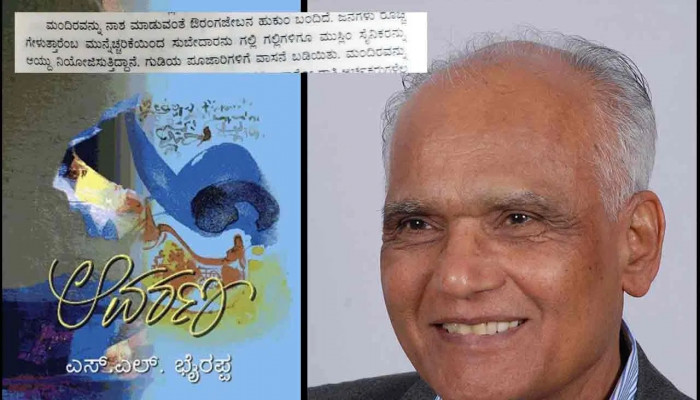ಆವರಣ (Avarana): A Magnum Opus
- In Book Reviews
- 12:06 PM, Jun 19, 2023
- Venkatesh Kikkeri
ಆವರಣ, “Avarana” when transliterated to English, the Kannada literary work of Saraswathi Samman and Sahitya Academy awardee, Padma Shri and Padma Vibhushan Sri S L Bhyrappa ji, gets commonly referred to as a work of Literary Fiction. After having read this, I refuse to refer to this work as Literary Fiction or a Historical Novel. This masterpiece transcends literature, carving a realm of its own, with no contemporary work to match let alone surpass the standards this masterpiece has set. In fact, literature only serves as a medium, an agency for the author to weave a magnum opus. When the author in the preface refers to his work as “ಐತಿಹಾಸಿಕ ಕಾದಂಬರಿ” – meaning, a “Historical Novel” he is only being very humble and is an example for humility personified.
ಆವರಣ (Avarana) means a “veil” in English. In the context of this work, it is the veil of lies covering the truth. Delving further, it is ‘true history’ which has been covered by a veil, a veil of lies. To be more specific it is the history of persecution and genocide of Sanatanis by various Islamic invaders especially the Mughal tyrants, in their bloodthirsty jihad against the idol worshippers of Bharat. This history is hidden behind the veil of appeasement and secularism.
The storyline of ಆವರಣ (Avarana) is about a Muslim couple, both filmmakers, the turbulence in their marriage, the interaction and influence of leftist Urban Naxals on the society in general and on the couple in particular, and the Government of the day wielding its power to silence those who oppose secular ideology. However, it is the history, the truth of Islamic rule in Bharat, which is actually the core of ಆವರಣ (Avarana) around which the entire story is weaved.
The author’s research is spellbinding and the sources of the history of Bharat referred to are impeccable and humongous. The author has skilfully intertwined the real History of Bharat with the characters and achieves the objective of narrating the truth to the readers without the reader getting disinterested.
To script a magnum opus like ಆವರಣ (Avarana), apart from the literary skills, it requires immense courage of conviction, impeccable integrity and the will to take on the secular establishment, the consequences of which are severe. As quoted by Sri Sandeep Balakrishna, founder editor of the portal Dharma Dispatch, an eminent author, columnist, public intellectual and independent researcher who has also translated ಆವರಣ (Avarana) to English (titled Avarana: The Veil), Sri Bhyrappa ji responding to a question on whether he didn’t feel scared to write such a no-holds-barred novel like ಆವರಣ (Avarana) says thus: “my view of literature is that it is a quest for truth, and if I don’t tell it even now, I think that there will be no meaning for my life. The freedom of expression that our Constitution guarantees us also includes the freedom to tell the truth”. Bhyrappa ji has emerged victorious. The fact that the magnum opus is in its sixtieth reprint (2021) and has been translated into five languages is ample evidence of the success of ಆವರಣ (Avarana).
Even after more than 16 years since its release ಆವರಣ (Avarana) continues to be reviewed, critiqued and debated. There are no prizes for guessing that the criticism has been predominantly from the Left-leaning individuals, thinkers, authors and institutions for, their edifice of falsity has been broken once and for all, which no other literary work in any of the native languages had done ever before. While scholars like Sri Sita Ram Goel, Sri Ram Swarup, Sri Jadunath Sarkar, Sri R C Majumdar etc have contributed enormously to bust the fake historical narrative of the Left through their research-based writings, the writings did not get much acceptance amongst the masses probably because of the English language acting as a barrier to the masses. ಆವರಣ (Avarana) which was first released in Kannada, found mass acceptance.
Without divulging the plot and core of the story the key messages worth taking home from ಆವರಣ (Avarana) would definitely be the following:
- Bharat’s history especially from the earliest Islamic invasion till Independence is not what it is taught to the youngsters at schools and colleges. The invaders are glorified and the natives are othered and let down in the name of appeasement and secularism.
Author Koenraad Elst in his path-breaking book titled “Negationism in India – Concealing the Record of Islam” defines Negationism as the ‘denial of historical crimes against humanity’.He points out that India has its own full-fledged brand of negationism, a movement to deny the large-scale and long-term crimes against humanity committed by Islam.This movement is led by Marxists, Islamic apologists and followed by politicians, journalists and intellectuals calling themselves secularists.An entire establishment supports Islam negationism in India having full control of media and educational institutions amongst other centres of power.
It is negationism that has denied the true history of Bharat to be narrated.Hindu genocides committed by Islamic conquerors in the name of jihad have been whitewashed.Crimes against Sanatanis especially during the Mughal rule finds no place in our history books.
Without understanding the pain and the sufferings of our earlier generations which they underwent to preserve our dharma, we have the temerity to equate Sanatana Dharma with others subscribing to the secular ideology. ಆವರಣ (Avarana) based on well-researched historical sources, graphically depicts the enormous pain and suffering the Sanatanis were subjected to under Islamic rule especially the Mughals. They are our unsung heroes.
- We have cheated generations and generations of Bharatiyas spanning across centuries by teaching "fake history". Our history has been nothing but a wicked dance of negationism over the genocide of Sanatanis, to say the least. Fake historians had ruled for quite long without anyone busting their falsity. This has had a serious impact on the society at large. In the author’s own words “ಇತಿಹಾಸಕಾರನೇ ಇತಿಹಾಸವನ್ನು ಕಾಣುವ ಕಣ್ಣಿಗೆ ಅಡ್ಡ ನಿಂತರೆ ಗತಿ ಏನು”? The broad import of the statement is “what would be the consequence if the historian himself obstructs one from perceiving the true history”? ಆವರಣ (Avarana) depicts truth, unabashedly.
- There are innumerable sources to understand our true history. We should be intelligent enough to separate the wheat from the chaff.
- While religious reformers have targeted Sanatana Dharma and diluted many of its tenets, they have been unsuccessful with other religions. This is one of the major reasons for many interfaith marriages break since conversion is forced only on Sanatanis. Post-conversion of their faith, they will not be treated at par with other people of the faith to which they have been converted. At a societal level, the onus is purely on the other religions to tone down their radical mindset in the interest of probable co-existence.
- Most of the temples belonging to the Sanatanis were razed to the ground by the Islamic tyrants and mosques were built in their place. There are ample historical references and sources to prove the hitherto existence of a temple where a mosque stands now in places like Kashi and Mathura.
ಆವರಣ (Avarana) can definitely be placed on that high pedestal.
References:
- Wanted: An Honest Body of Literary Fiction about the Partition of India – An essay by Sri Sandeep Balakrishna- https://www.dharmadispatch.in/commentary/wanted-an-honest-body-of-literary-fiction-about-the-partition-of-india
- ಆವರಣ – 2021 reprint published by Sahitya Bhandara, Bangalore.
Image source: Kannada News
Disclaimer: The opinions expressed within this article are the personal opinions of the author. MyIndMakers is not responsible for the accuracy, completeness, suitability, or validity of any information on this article. All information is provided on an as-is basis. The information, facts or opinions appearing in the article do not reflect the views of MyindMakers and it does not assume any responsibility or liability for the same.







Comments